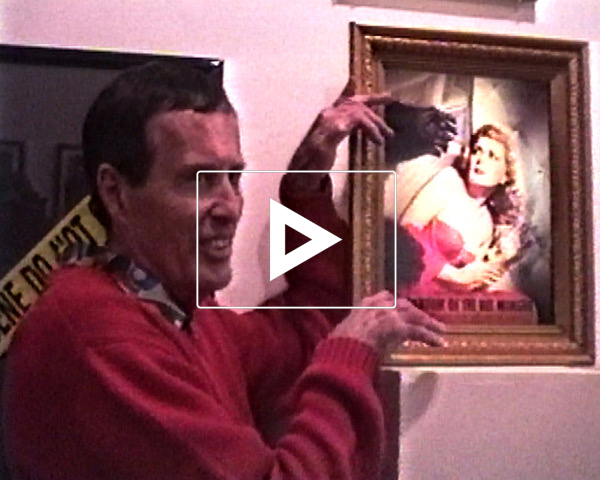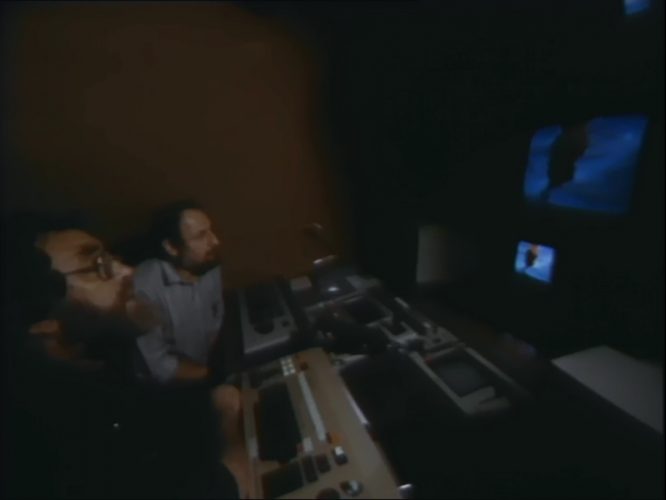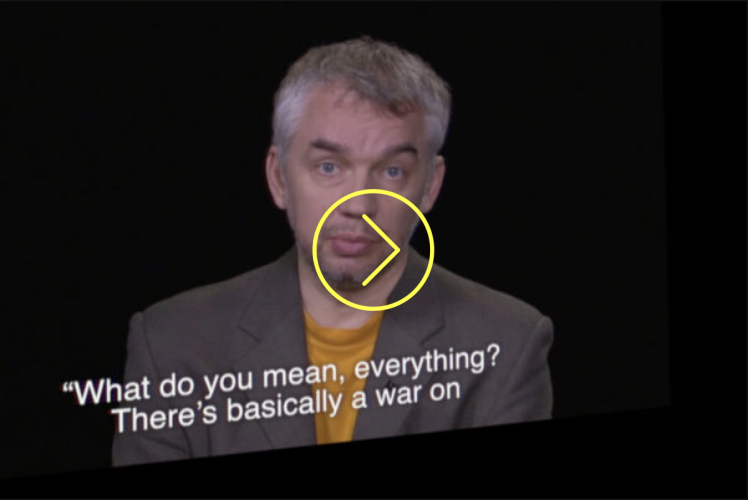Date: 01.05.2020 — 31.05.2020
Curators: Markéta Jonášová and Tomáš Kajánek
The online exhibition project titled The Moving Image Friends Association presents both historical and contemporary models of collectives, established for the sake of supporting the production, presentation and research of film and video art. By comparing those collectives, the project explores how the shared interest in the moving image medium, present-day political context and prevailing social conditions form the ways in which the art collectives functioned. Screenings of films on the gallery’s website, accompanying texts and artist’s research will present the work of Anthology Film Archives, Czechoslovak group Obor Video, and D’EST platform.
Production: Anna Davidová, Graphic design: Nela Klímová, Web design: Ondřej Roztočil, Collaboration: Adéla Komrzý, Alžběta Bačíková, Ulrike Gerhardt
Project was created in collaboration with Adéla Komrzý and D’EST platform. Financial support was provided by the Czech Ministry of Culture and Prague City Hall.
THE SCREENING IS ONLY AVAILABLE ONLINE ON THE WEBSITE OF THE ETC. GALLERY ON THE PAGE “CINEMA”.
PROGRAMME:
24. 5. – 20:00 – Laboratorium Anthology, Jonas Mekas & Auguste Varkalis
26. 5. – 20:00 – Obor video, Petr Skala: Videoart, Radek Pilař: Zrcadlo času, in collaboration with Adéla Komrzý
27. 5. – 20:00 – D’EST, Debates on Division: When Private Becomes Public, Anna Bitkina & Gluklya
THE MOVING IMAGE FRIENDS ASSOCIATION
A sentence in the voice-over commentary accompanying Petr Skala’s short documentary from the 1990s is one which can even nowadays be often heard when discussing the history of Czech video art: “Compared to the world, Czech video art might be belated, but it did go its own way”. When Czech and Western video art are compared it usually ends in a comparative evaluation that devalues the former. However, it is not the work of the local artists that is belated but rather the ideas on which this comparison is based. If there is something belated concerning the history of video art, it is the understanding of art history in terms of a monolithic development of art forms, derived from the universal (meaning Western) spirit of progress. Moving image resists such a notion of history more than any other art form, because the history of its production is closely linked to the concrete development and accessibility of technologies for its recording and broadcasting – and that, in turn, is determined by particular social, economic, and political conditions, not by an abstract linear development. For the development of video art in Western countries in the 1960s, the availability of technical equipment was as important as the embracing of neo-avant-garde art by artists at the time. Portable video recorders and cameras represented convenient means of capturing performative artworks and mediating socially engaged art practice, while also opening a new field for conceptual and media experiments (Meigh-Andrews, 2013). The lack of structures for the support of moving image production and presentation, as well as the necessity to cooperate based upon the complex nature of the medium, led artists to search for new organisational structures, and in so doing, also for new forms of institutional practice. The existence of institutions that supported audiovisual art, or – on the contrary – the scarcity of such institutions, is closely related to the present-day possibilities of moving image circulation, which is dependent on available technologies and prevailing social-political conditions.
In the field of experimental film, these issues emerged even before the expansion of video art in the late 1960s. According to the artist and theoretician Stuart Marshall, it was the activities of American experimental filmmakers that served as an example to video artists searching for new models of distribution and self-organisation (Marshall, 1985). American art dealer Howard Wise closed his gallery in New York in 1970 to establish the non-profit organisation named Electronic Arts Intermix, which has become throughout its 50-year long history one of the most important institutions for the distribution, preservation, and research of media art. With the same mission, the London Video Arts platform (currently LUX) was established in 1976, followed by the organisation Montevideo in Amsterdam, and Vtape in Toronto (Balsom, 2017). The archetype of these institutions is the model of a film association providing paid rentals of entrusted works, as established in the United States after the Second World War. Historically, the most influential association is the New American Cinema Group, which (shortly after its establishment) initiated the foundation of the New York Film-Makers’ Cooperative (Mekas, 2016). Due to the growing number of works the cooperative collected over the years, the artists felt the need to establish an institution that would enable uncensored presentation, and later also the preservation of these marginalised experimental films. The cinematheque of the New York Film-Makers’ Cooperative found its permanent location in 1970 and institutionalised its activities under the name Anthology Film Archives.
A leading figure of the filmmaker’s association in New York, and the first director of the Anthology Film Archives was Jonas Mekas, a renowned representative of the post-war film avant-garde. From the beginning of his career, Mekas had been an advocate of making film-as-art accessible to as broad an audience as possible, which in turn influenced the activities of Anthology Film Archives – in addition to a screening hall, a study centre was established (which also functioned as an exhibition space), as well as a library, a conference room, and facilities for the long-term preservation of films and other archival documents. Even though the new institution appropriated a number of traditional museum functions, its day-to-day functioning was informal and based on the (often precarious) work of the arts community. The activities of the archive are up to the present days funded from both public and private donations, with a significant portion of its income coming from members’ fees. The way the archive used to operate is depicted in Mekas’ documentary Laboratorium Anthology from 1999, for which most of the scenes were shot by the composer and filmmaker Auguste Varkalis. Laboratorium recalls the iconic performances that took place in the archive, as well as mediates an insight into the backstage running of the institution. In the documentary, Mekas himself hints that the establishment of the archive was not without controversies and problems, which often stemmed from the lack of finances or disputes over the management of the institution. The archive was also subjected to criticism for the subjectivity of the criteria that its committee, chaired by Mekas, followed when selecting films for the Essential Cinema programme; the purpose of which was to present viewers with a selection of canonical experimental movies. None of the committee members was a woman and only a few female filmmakers were selected (Alfaro, 2012). Despite this criticism, the contribution of the Anthology Film Archives to the development of film as art can not be disputed, as illustrated by the documentary that captures the performances of Nam June Paik, Joseph Beuys or Patti Smith, as well as the effort spent on the preservation of film stock and other archival materials.
Jonas Mekas & Auguste Varkalis: Laboratorium Anthology (1999). The film was streamed on the 24th May 2020. A shortened version of the movie is available online on jonasmekas.com.

It was impossible to establish an association similar to the New American Cinema Group in post-war Czechoslovakia. After 1948, independent artists’ unions were eliminated or subordinated to the centralised Union of Czechoslovak Fine Artists, while the ideological control of film production was exercised by the Czechoslovak State Film. A short period of ideological loosening and decentralisation was immediately followed by a new surge in censorship and the Communist Party’s policing of cultural production after 1968. Many important representatives of the avant-garde art scene emigrated, and those, who stayed, found themselves isolated without the possibility to gain institutional support for their art practice. As a result of the policing of artists’ associations by the state apparatus, which included censorship, the need to embrace traditional artistic genres, as well as the inaccessibility of equipment for the recording and playing of videos, the institutionalisation of video art in socialist Czechoslovakia did not develop in the same way as it did in the West. There were two significant movements founded after 1968; Independent Video Art Prague, established under the Institute of Industrial Design, and the association Obor Video, which only started to form in 1987 within the Union of Czech Fine Artists.
One of the main reasons leading to the foundation of the group Obor Video, initiated by the artists Radek Pilař and Petr Skala, was to secure institutional support for the technically intensive and costly production of video art. The core philosophy of the group was to develop video practice not only within art but also in other cultural fields while maintaining a free and creative atmosphere inside the group. Even though the inner running of the group enabled free experimenting, its external activities were still controlled by the Union of Fine Artists. Hence, interventions by censors shaped the first exhibition of the group titled Day of Video (Den videa), which took place within the official Salon of Applied Arts in 1989. Radek Pilař’s video titled Mirror of Time (Zrcadlo času) had to be exhibited without the music of Michael Kocáb and Michal Pavlíček, despite the fact that the music was an inherent part of the work (Kerbachová, 2006). For decades, the agenda of the Union prioritised traditional art forms and subject matters, whereas neo-avant-garde tendencies were pushed to the periphery of the art scene.
In their art practice, several members of the group were drawing on avant-garde tendencies and traditional art disciplines, combined with animation and film graphics. Radek Pilař studied painting at the Academy of Fine Arts in the 1950s, and in his experiments with moving image often applied fine art methods. The particular combination of painting, photography, and animation is evident in Pilař’s presentation of Mirror of Time within a complex installation Report on the State of Water on Czech Watercourses (Zpráva o stavu vod na českých tocích), which was created for the exhibition Day of Video. Mirror of Time was showcased on three television screens positioned at eye-level, under which were photographs of screwed up paper, and a photograph of a young girl stained with colourful splodges. The whole installation was reflected in a mirror located on the floor in the middle of the installation. In the documentary of Petr Skala, Radek Pilař is depicted while working on the video Mirror of Time and these scenes are accompanied by a commentary that captures the present-day understanding of the video art field in between traditional genres and new technologies; “Video art – a new type of art that uses the electronic image as a means of expression… Modern technology penetrates the dignified and the centuries motionless world of images and sculptures to endow the artefact with motion and time.”
Radek Pilař captured editing the work Mirror of Time (1987–1991), screenshot from Petr Skala’s documentary Videoart (1990)

In Western countries, the emergence of independent platforms for the support of audiovisual art has been related to the foundation of new university and museum departments since the 1960s (Alfaro, 2012). A major transformation of art institutions in Czechoslovakia was only brought about after the Velvet Revolution, which – in the field of new media – resulted in the opening of new departments at art academies. After the collapse of the centralised Union of Fine Artists, the Czech art scene separated into smaller associations, which gradually led to the establishment of independent galleries and organisations. Even though these institutions created the conditions for the display of media art, they usually operate within limited means and reach only a small audience. Art museums no longer avoid the presentation of video art, but lack the necessary expertise and infrastructure, and appropriate strategies for the acquisition, research, and preservation of new media art are yet to be implemented. Despite the increasing accessibility of technology for the recording and broadcasting of moving image, the category of “art videos” has found itself in an odd abyss between the structures of the art and film world, without its own production or distribution platform. However, Western artists are also familiar with operating in between the art and film scene, as the established model of paid rentals increasingly competes with other models of film distribution – such as DVDs, limited editions, streams, and non-authorised online circulation – which correspond to different formats of video art presentation (Balsom, 2017).
The crisis resulting from the COVID-19 pandemic accelerated the digitalisation of the art world. An increasing number of virtual exhibitions, databases and portals have released a growing amount of audiovisual artworks to be watched online. The main criteria for watching these works is no longer the physical location of the viewer but rather our language skills and the speed of our internet connection. The possibility to freely cross national borders, and by doing so also to fill blank spaces in a shared cultural history, is a focal point of the online cultural platform D’EST, the foundation of which was initiated by the cultural studies scholar and curator Ulrike Gerhardt. Throughout 2018, the platform produced six screening chapters, developed in collaboration with many curators and artists from the countries of the so-called “former East”. These chapters presented audiovisual artworks that reflect feminist and collective perspectives on topics related to the post-socialist transformation, such as the notion of historicity mentioned in the introduction which is derived from the ideological relation of East and West. This particular focus of D’EST contributes to the development of an international professional community, which – by the means of moving image – shapes critical reflection of shared historical experience. In the world of transnational virtual galleries, such an embracement of research and collective practice is rather unique, and poses profound questions about their future mode of operation: How and by whom should the content of these online galleries be curated? For whom is their programme intended? And what forms of production and distribution can secure sufficient financial support of the artists in question?
D’EST, Debates on Division: When Private Becomes Public, Anna Bitkina & Gluklya

Markéta Jonášová
References:
Alfaro, K. (2012). Access and the experimental film: New technologies and anthology film archives institutionalization of the avant-garde. The Moving Image, 12(1), 44–64.
Balsom, E. (2017). After uniqueness: a history of film and video art in circulation. New York: Columbia University Press.
DEN VIDEA 1989/ 2018 (2018). Den videa 1989/ 2018: První skupinová výstava českého videoartu. Doprovodný text k výstavě.
Kerbachová, B. (2006). Počátky českého videoartu. Iluminace, 18(2), 133–158.
Marshall, S. (1985). Video: from art to independence. Screen, 26(2), 66–72.
Meigh-Andrews, C. (2016). A history of video art. London: Bloomsbury.
Mekas, J. R. (2016). Movie journal the rise of new American cinema, 1959-1971. (G. R. Smulewicz-Zucker, Ed.). New York: Columbia University Press.